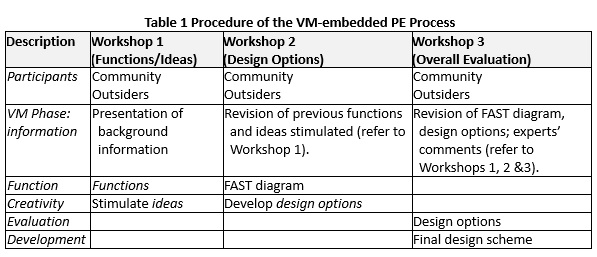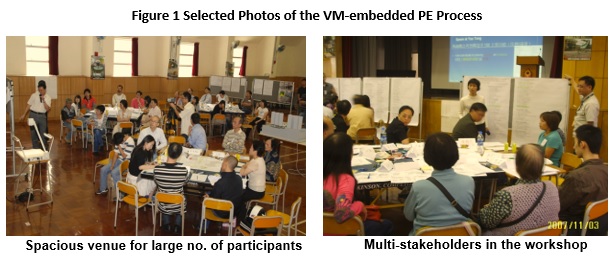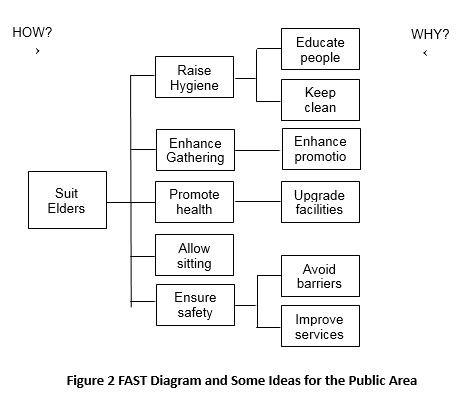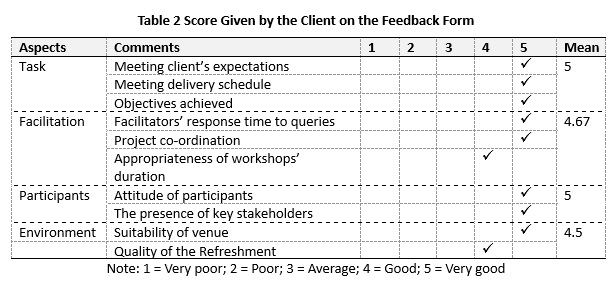By Mei-yung Leung and Qi Liang
The design of public areas should meet the rapidly changing and increasingly diverse needs of different stakeholders, especially the needs of elders, who have special needs concerning space, facilities and so on. Unlike young people, elders face characteristic problems caused by their aging bodies; they are vulnerable to various diseases (e.g., dementia, Parkinson’s disease and depression); have reduced mobility, and so on. Researchers have claimed that the physical environment – such as lighting, private space and so on – can affect elders’ health and well-being (Leung et al. 2013). For instance, if hygiene standards do not meet specific criteria, pneumonia and food poisoning become common in elders who have a weak immune system. Hence, it is critical to consider the unique characteristics of elders while designing public areas they will use.
Public engagement (PE), as one of the popular ways to enhance democratic decision-making and to ensure the satisfaction of the various stakeholders, has been widely applied in the USA, UK and other places (Marquart-Pyatt and Petrzelka 2008; McCoy and Scully 2002). It is a series of team decision-making processes that involves many stakeholders in various project stages for resolving problems and satisfying multi-stakeholders (Chan et al. 2007; Rowe and Frewer 2005). Through the implementation of PE, different parties can communicate and share ideas with each other, reach consensus and work together to achieve better final results (Yang et al. 2011). With PE, the government and experts are responsible for forming the overall picture and identifying macro issues; the end-users (e.g., local elders) improve the micro design according to their special needs, day-to-day experience and involvement with a public area.
However, despite the wide application of PE in the design of public areas, policy-making and so forth, it is not uncommon for the stakeholders to be unable to reach consensus due to their different backgrounds, unsolved problems, limited resources, unclear goals and so on. Given that elders are easily affected by the external environment and events (Cerin et al. 2013), the PE process for projects related to elders may be even more problematic.
Given the advantages of VM, this study integrates the VM job plan into the PE process for the design of a public project related to elders, in order to satisfy end-users’ needs, facilitate mutual understanding among participants, and improve the final outcome.
The VM-embedded PE Process
PE is normally adopted for complicated huge development projects, therefore a clear overall picture of project goal and tasks are necessary, particularly in the beginning stage (Leung et al. 2014). To facilitate the discussion among multi-stakeholders, PE organizer should present all information at the beginning of the VM-embedded PE process, and all the stakeholders should be open and honest to each other.
Unlike public participation in which members of the public merely comment on proposals presented by the government and experts, PE emphasizes the role of participants and their participation in the decision-making process. The participants for this VM-embedded PE process can be broadly divided into two groups, namely, community members and outsiders. The community members consist of those who are socially and/or geographically connected with a community, such as district council members, residents (e.g., elderly inhabitants) and social workers. The outsiders are defined as those who are outside of the community but can nonetheless exert an impact on the community, such as government officials, professionals, etc.
In fact, the facilitator needs to control the overall program and ensure good communication and coordination throughout the team discussion and decision-making. On the other hand, venue is also playing an important role for success of VM-embedded PE activities (Norton and McElligott 1995), especially for those involved elders, because elders are easier than young people to be affected by their environment (Cerin et al. 2013). It is necessary that all the participants can view the stage/screen clearly, and there was enough space for displaying the models, photographs, drawings, etc.
RESEARCH METHOD
Research Design
The study aims at exploring the potential of VM in improving the outcomes of PE processes for projects related to elders. The research method is real case study, which is a powerful and reliable research method and has wide applicability (Cooper and Schindler 2006). As defined by the client, the VM-embedded PE process in this case is: 1) to involve local elders and other stakeholders in the decision-making process for the design of the public area; 2) to identify the needs of local elders and other users regarding this public area, taking into account of the elders’ characteristics (e.g., changing physical condition with age); and 3) to educate local elders and the other stakeholders about PE.
To ensure that it is representative and comprehensive, all participants, including community members and outsiders, should be included in this VM-embedded PE. A facilitator plus several co-facilitators were invited to preside over the whole VM-embedded PE process and manage the programme. They helped the participants to understand the common objectives, analyse complicated information, generate ideas and understand the VM process. In addition, some helpers were also recruited for the venue set-up, registration, audio-visual recording and so forth. Before each workshop, meetings were held for the key participants and the facilitators in order to establish a common understanding of the project background and the key elements of the VM-embedded PE process, including its purpose, constraints, the programme, the contents, the venue and the invitation arrangements.
Procedures
As the PE process normally involves a huge number of stakeholders who need to study complex problems that are difficult for some stakeholders (e.g., elders) to understand, it is hard to rely on just one single activity for resolving all the problems and making the final decision (Petts 1997). Hence, the current VM-embedded PE process consists of three workshops with different objectives: the first workshop covered functions and ideas, the second workshop covered design options, and the third workshop was for an overall evaluation (see Table 1).

The participants, including the elderly ones, went through the VM-embedded PE process with the guidance and assistance of a qualified VM facilitator (see Figure 1). Various VM techniques were used, such as FAST for diagramming functions in the function-analysis phases, brainstorming for generating alternative ideas in the creativity phases, scoring approach and star diagram for the evaluation of ideas in the evaluation phases.

In Workshop 1, the selected participants went through three phases of the VM job plan, including an information phase to introduce the background information of the project, an analysis phase to identify the functions of the public area and a creativity phase to stimulate ideas. The outcomes of this workshop are abundant and include a set of functions of the public area, and ideas for satisfying the elders in the community (see Figure 1 and 2).
The purpose of Workshop 2 is to develop design options. After rating and diagraming the functions and ideas in the workshop 1, participants were invited again for function analysis and creativity phases. They reviewed the information discussed in Workshop 1, identified key functions and develop a FAST diagram and selected their preferred ideas for the development of several design options. The final outcomes of this stage are the FAST diagram and major ideas for improving the design options (see Figure 2). As shown in the FAST diagram, in order to Suit Elders in the public area, the participants identified five primary functions, including Raise Hygiene, Enhance Gathering, Allow Sitting, Ensure Safety and Promote Health; and some secondary functions, such as upgrade facilities, enhance promotion, educate people, and keep clean. Following this up, the participants developed several ideas in the creativity phase for each function so as to improve the public area in term of suiting elders. These are the following. 1) Raise Hygiene: provide public toilets and a drinking-water fountain, use safe materials, do weeding to avoid the spread of pests, educate in the proper use of the area and provide appropriate instructions; 2) Enhance gathering: provide a ‘happy garden’, construct a circular stage, provide an electronic notice board and so on; 3) Allow Sitting: provide a variety of comfortable, wide, height-adjustable seats in suitable locations, as well as a tuck-shop with tea house and a wharf restaurant; 4) Ensure safety: Install a wireless safety alarm, first aid station, non-slip tiles and handrails, and provide barrier-free passages; and 5) Promote health: provide a full set of sports facilities for exercise, grass plots and pebble walkways for walking, a bicycle lane and so on.

The final workshop, Workshop 3, was conducted with the objective of developing an integrated design scheme. In the information phase, all the community members and outsiders worked together to review the FAST diagram and design options. As the functions, ideas and design options had been raised and developed in Workshops 1-2, the participants mainly concentrated on the evaluation and development phases of this workshop. Scoring approach and a star diagram were adopted after the detailed discussion in the evaluation phase. All the participants – both the community members and the outsiders – were fully satisfied with the final integrated design. Due to confidentiality issues, the final integrated design scheme cannot be published in this paper.
RESULTS
The three-stage VM-embedded PE process established a platform for all the participants (both the community members and the outsiders) to work together to explore elders’ needs and wants, and thereby improved the design of the public area in question. In fact, feedback from the client clearly confirmed that the VM-embedded PE process is a successful one; the feedback form covers various aspects, including the tasks, facilitation, the participants and the environment. The details of the client’s scores regarding the four aspects are shown in Table 2.

The client gave a score of 5 out of 5 for all three task items (meeting the client’s expectations, meeting the delivery schedule and achieving the objectives) and for the two participation items (the attitudes of the participants and the presence of key stakeholders). This demonstrates that, through this VM-embedded PE process, the client’s expectations and the project objectives are met through the participation of representative stakeholders. The scores given by the client for facilitation and environment are also high, the average score being 4.67 and 4.5, respectively. The client gave an average score of 4.8 out of 5 for the whole VM-embedded PE process.
DISCUSSION
Based on the successful outcomes, some critical factors for the success of the VM-embedded PE process should be pointed out. Firstly, clients’ expectation, objectives, all the constraints and restrictions must be reported to all the participants at the beginning of each workshop, so that they can clearly know the goal of the project and of each task. Otherwise, incorrect and inadequate information may misdirect the PE process, causing a waste of time and resources. Secondly, it is very important for the facilitator to have a logical mind-set for problem solving, good communication and co-ordination skills, basic knowledge of the problems being discussed and the ability to manage the process in its entirety. If not, the whole PE process would be very tedious and problematic, because of the huge number of participants and the differences in their backgrounds, interests, values and so on. Thirdly, to facilitate participation, meeting times convenient for the participants are necessary (say, Saturday and Sunday); and meetings should not be arranged in a politically sensitive period. The participants’ early invitation is important, to allow sufficient time for confirmation and follow-up action. In addition, it is better if the venue (i.e., the environment) for the PE activities is close to the area under discussion, and the venue should be well-prepared with respect to such matters as the visual presentation of information and/or the physical models in the venue.
CONCLUSION
Elders are more easily affected by their external environment than young people are; thus, the design of a public area that accommodates their needs requires special attention. PE is a popular approach to enhance democracy and satisfy the needs of the various stakeholders, and it has been widely applied in the design and construction of public areas. However, PE has long been criticized for being illogical, for ignoring stakeholders’ expectations, for being impractical and time-consuming, and so forth. VM, as a logical and systematic team decision-making tool, has been applied in the construction industry, especially at the design stage. It can improve the efficiency of a project in terms of its time, cost and the quality of the outcome, and better satisfy stakeholders’ needs. Hence, the current study integrated a VM job plan into the PE process so as to improve the design of a public area for elders.
The VM-embedded PE process consists of three workshops, and both community members (e.g., local elders) and outsiders participated. To Suit Elders was identified as the purpose of the public area, and the participants developed a FAST diagram to promote this; they also suggested many alternative ideas for improvement, such as the provision of public toilets, the use of safe materials, and so on. Various VM techniques were used by the participants to identify and evaluate functions and ideas; these techniques include FAST diagram, scoring approach, star diagram, and so on. The final star diagram shows that the participants were most satisfied with the design intended to meet the needs of elders. In addition, the high score given by the client on the feedback form also supports the contention that the VM-embedded PE process was a successful one. Several factors in the success of the VM-embedded PE process have been highlighted: 1) having a clear goal for the project and for each task; 2) good facilitation; 3) having adequate participants; and 4) having a suitable venue. This study demonstrates the applicability of VM in PE processes and shows that it improves the design of public areas for elders.
ACKNOWLEDGEMENT
The work described in this paper was fully supported by the General Research Fund from Research Grants Council of Hong Kong Special Administrative Region, China [Project No. CityU 115113].
REFERENCES
- Berg, B.L. (2001) Qualitative Research Methods for the Social Sciences (4th eds.) Boston: Allyn and Bacon.
- CARE (2009) Stage One Public Engagement Programme of the Hong Kong Island East Harbour-Front Study. Public Engagement Report, Hong Kong: Centre of Architectural Research for Education, Elderly, Environment and Excellence Ltd, Hong Kong.
- Cerin, E., Lee, K.Y., Barnett, A., Sit, C.H.P., Cheung, M.C., Chan, W.M. (2013) Objectively-measured neighborhood environments and leisure-time physical activity in Chinese urban elders. Preventive Medicine, 56(1), 86-89.
- Chan, J.C.W., Cheung, P.T.Y., Chan, E.Y.M., Lam, W., Lee, E.W.Y., Chan, K.K.M. (2007) From Consultation to Civic Engagement: The Road to Better Policy-Making and Governance in Hong Kong. Hong Kong: Bauhinia Foundation Research Center.
- Cooper, D.R., Schindler, P.S. (2006) Business Research Methods (9th ed.). New York: the McGraw-Hill.
- Dell’lsola, A. (1982) Value Engineering in the Construction Industry (3rd. eds). New York: Van Nostrand Reinhold.
- Doelle, M., Sinclair, A.J. (2006) Time for a new approach to public participation in EA: promoting cooperation and consensus for sustainability. Environmental Impact Assessment Review, 26(2), 185-205.
- Ellegant, H., Bushman, D.O. (2000) Value Management: Changing the conversation- A SAVE approved Module I Course. U.S.A.: Howard Ellegant Associates.
- Fong, P.S.W, Shen, G.Q.P, Chiu, E.W.I, Ho, C.M.F (1998) Application Of Value Managament In The Construction Industry In Hong Kong. Hong Kong: The Hong Kong Polytechnic University, Hong Kong
- Yu, J.Y., Leung, M.Y. (2015) Exploring factors of preparing public engagement for large-scale development projects via a focus group study. International Journal of Project Management, 33(5), 1124-1135.
- Kaufman, J.J. (1998) Value Management. Grisp Publication Inc.
- Kelly, J., Male, S. (2001) Value Management in Design and Construction: The economic management of projects. London: Spon.
- Leung, M.Y., Ng, S.T., Cheung, S. (2002) Improving satisfaction through conflict stimulation and resolution in value management in construction projects. Journal of Management in Engineering, 18(2), 68-74.
- Leung M.Y., Chan Y.S, Olomolaiye P. (2013) Relationships between facility management, risks, and health of elderly in care and attention homes. Facilities, 31(13/14), 659-680.
- Leung M.Y., Yu J.Y. (2014) Value methodology in public engagement for construction development projects. Built Environment Project and Asset Management, 4(1), 55-70.
- Leung M.Y., Yu J.Y., Chan Y.S. (2014) Focus group study to explore critical factors of public engagement process for mega development projects. Construction Engineering and Management, 140(3), 04013061-1-11.
- Marquart-Pyatt, S.T., Petrzelka, P. (2008) Trust, the democratic process, and involvement in a rural community. Rural Sociology, 73(2), 250-274.
- McCoy, M.L., Scully, P.L. (2002) Deliberative dialogue to expand civic engagement: what kind of talk does democracy need. National Civic Review, 91(2), 117-137.
- Norton, B.R., McElligott W.C. (1995) Value Management in Construction: A Practical Guide. London: MACMILLAN.
- Hong Kong Special Administrative Region Policy Address (2011) The 2011-12 Policy Address – From Strength to Strength. Hong Kong: The Hong Kong Special Administrative Region.
- Petts, J. (1997) The public-expert interface in local waste management decisions. Expertise, credibility and process. Public Understanding Science, 6, 359-381.
- Rowe, G., Frewer, L.J. (2005) A typology of public engagement mechanisms. Science, Technology and Human Values, 30 (2), 251-290.
- WKCD (2010) Report on the Analysis of Views for the Stage 1 PE Exercise for the West Kowloon Cultural District. Hong Kong: WKCDA.
- Yang, J., Shen, Q.P., Bourne, L., Ho, C.M. Xue, X. (2011) A typology of operational approaches for stakeholder analysis and engagement. Construction Management and Economics, 29(2), 145-162.
